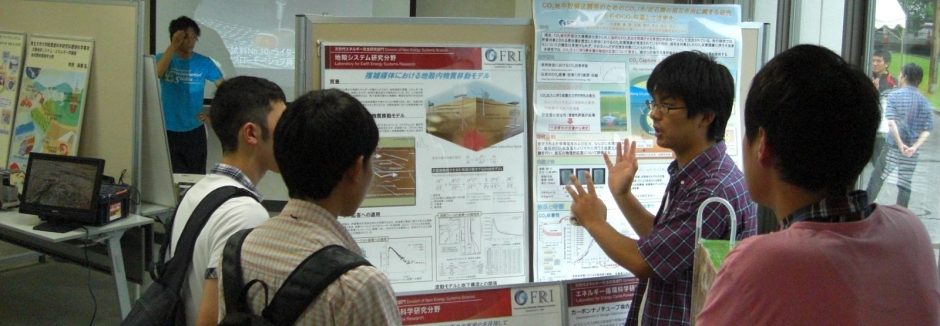Hashida Laboratory
【Publications】
Research
– Laboratory for Earth Energy Systems Research
Design of fracture type reservoirs for clean geothermal energy extraction
We have been developing a design code for fracture type geothermal reservoirs, incorporating a numerical model of hydraulic stimulations based on a fractal network of natural fractures and long-term fluid/heat transfer analyses of thermal extraction stages. The numerical code may be useful for further enhancement of the performance of existing geothermal reservoirs. We are also conducting a pioneering research on potential thermal extraction from deep-seated rock masses in which the temperature and pressure exceed the critical point of water.
Rock/water/ CO2 interactions and reliability assessment for underground sequestration of CO2
Our research team has been performing experimental investigations regarding physical and chemical interactions in rock/water/CO2 systems both for short- and long-term processes in order to assess the potential and reliability of CO2 geological sequestration. It has been demonstrated that absorption of CO2 onto rock pore walls may play an important role in the CO2 injection and storage, by measuring adsorption/desorption isotherms. Numerical computations of CO2 injection are also being carried out to examine the effects of injection parameters and rock/water CO2 interactions on the expansion of a CO2 reservoir, and to understand its mechanical and chemical stability of the rock mass of interest. The ultimate goal of our research team is to establish a CO2 circulation technology for mitigating the emission of CO2 into the atmosphere.
Modeling of mass transport in inhomogeneous rock masses
Modeling of mass transport in underground rock masses is of crucial importance for the development of engineered subsurface systems. It is quite common that underground rock masses of interest possess significant heterogeneities and disorder, and often contains a complex network of fractures, to which the classical theories of flow through porous media such as Fickian law is inapplicable. Our research is targeted at the development of a simple but holistic model for complex flow behavior in inhomogeneous rock masses by invoking a mathematical model of fractional derivative. Specifically, we are aiming to quantify the global characteristics of complex flow on the basis of field tracer responses.
– Laboratory for Energy Cycle Research
Fabrication and reliability evaluation of solid oxide fuel cells (SOFCs)
Solid oxide fuel cells (SOFCs) represent a next-generation hydrogen energy technology. To date, SOFCs of various types and designs have been developed worldwide. It is a crucially important and urgent task to ensure the relibility and durability of the SOFCs for the realization of their practical applications. Our research is focussed on the effects of interactions between material, mechanical, electrical, and chemical factors (MECh interactions) on the performance and durability of SOFCs. We have been developing a constituent element testing method for determining the fundamental mechanical properties and a cell testing method for evaluating the critical operating conditions as a durability limit of SOFCs, and the experimental approach is coupled with numerical simulations using finite element method (FEM) and molecular dynamics (MD). The integrated approach is being utilized to elucidate the MECh interactions and to establish a methodology for designing high-performance, high-reliability SOFCs. In addition, we are developing coating technologies for preparing thin electrolytes in order to reduce the operating temeprature of SOFCs.
Synthesis of carbon nanotube nano-composites for new energy materials
Our research team has been developing a new class of materials, taking advantage of the unique and useful characteristics of carbon nanotubes (CNTs), with the ultimate objective of creating and producing novel energy materials for next-generation energy cycle systems. Specifically, our research is focused on the development of CNTs reinforced ceramic matrix composites. A precursor method, rather than the conventional mixing method, is being developed as the synthesis method for CNT nano-composites in order to control the spatial dispersion of the nano-scale reinforcement and the interface. We are performing a systematic experiment for evaluating the mechanical properties such as strength and toughness, and friction and wear, and the electro-magnetic properties including electrical conductivity and interaction with magnetic waves.





